
the Milena principle : Estate & Archive

Stefaan van Biesen and Anna-Maria Mestdagh were approached by the CVK (Center for Flemish Art Archives) to discuss how the heritage of their artistic oeuvre and that of the Milena principle (+ Wit Urban Team), can be preserved for the future and can be consulted for possible scientific research.
The heritage includes videos of their projects and performances by fellow foreign artists. Thus, beyond the fisical archive, there is also a digital archive that should find its place in future art history & research.
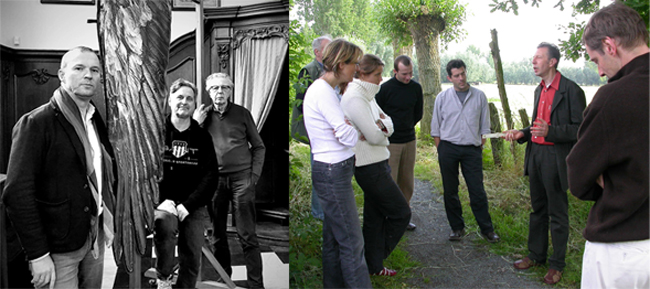
Filip Van de Velde, Geert Vermeire & Stefaan van Biesen. Photos: Anna-Maria Mestdagh 2006 & 2025.
On Oct. 22, 2024, the core group of the Milena principle met to discuss how to manage and preserve our organization's heritage and archives. Geert Vermeire (director of art projects) and the board of directors: Filip Van de Velde (SMAK, Ghent), Anna-Maria Mestdagh and Stefaan van Biesen, both trustees of the private foundation Van Biesen-Mestdagh.
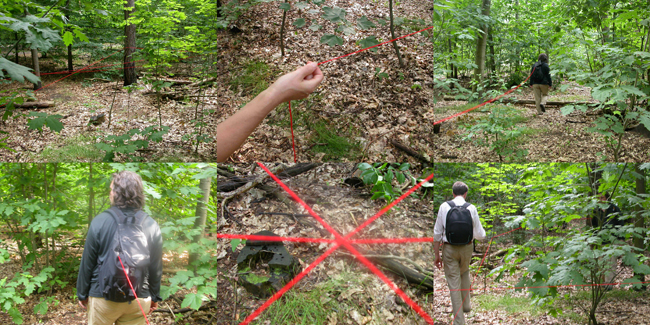
The Milena Principle: Art, Ecology, and Cross-Border Collaboration
The Milena Principle is a multidisciplinary project where art intersects with a strong cross-border dimension. Ecology, understood broadly to include environmental, sociological, social, and economic aspects, forms one of the core conceptual foundations of the Milena Principle. Every project begins with an ecological perspective.
We collaborate with environmentalists and art centers that integrate art and ecology into their practice, such as the Convent of Tibães in Portugal, Der Wachsblock, and Ingrid Pee in Germany.
Ecology for us is also a state of mind: the indecision or neglect surrounding the remediation of contaminated sites serves as a powerful metaphor for “postponing the future.”
![]()
History and name | Origine and shaping a network of friendship
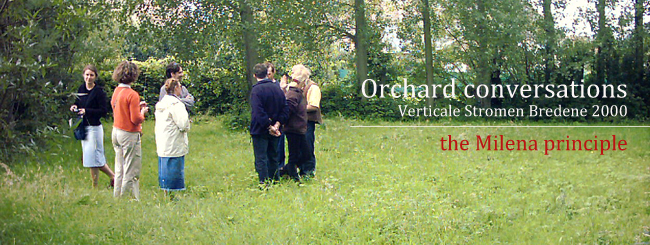
the Milena Principle: Over Two Decades of Collaborative Art Practice
It is with both amazement and pride that we mark more than 20 years of the Milena Principle. The journey began during the art project ‘Vertical Flows’ (Verticale Stromen) in Bredene, Belgium, in 2000. Curated by art historian Filip Van de Velde and organized by Geert Vermeire, this project brought together a group of like-minded friends who, without any formal structure at the time, decided to work together regularly.
The photograph above is one of the few surviving images from an informal meeting—an ‘orchard conversation’ held in preparation for the project. At that moment, the idea of an official organization had not yet taken shape. This image symbolizes the birth of the Milena Principle and its ongoing evolution.
Twenty years later, the Milena Principle has grown into a nomadic organization based in Belgium, with active partnerships across Europe and beyond. Our collaborations span institutional art organizations, museums, universities, art schools, collectives, as well as individual experts, academics, and artists from diverse disciplines.
The Milena Principle was officially founded during the first ‘Table of Meetings’ in early summer 2003 and manifested shortly after in the exhibition ‘Omtrent Melancholie’ (About Melancholy), curated by Filip Van de Velde. These formative moments were unplanned yet deeply sought after opportunities that we embraced.
The Milena Principle did not emerge from a formal program but rather from the convergence of experiences and artistic paths of its founding members—an organic evolution rooted in their shared creative journeys.
Photo: Gepäckträger | Table of Meetings in the house of Niki Fröhling Amsterdam Netherlands 2006.
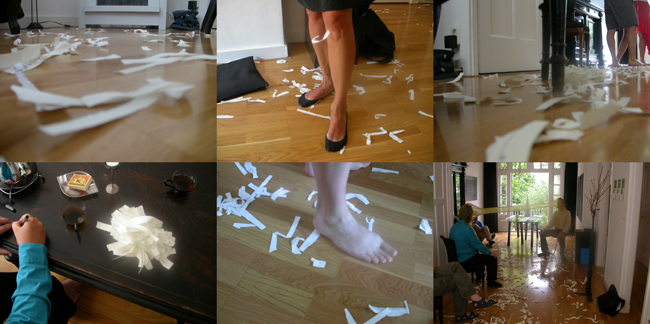
The name 'the Milena principle'?
The Meaning Behind the Name: The Milena Principle
In old Italian, Milena means “the beloved.” The name “The Milena Principle” honors the story of a young Bulgarian lawyer from Sofia who, after a turbulent period around the millennium, chose to follow her heart. This decision led her to leave behind a safe and settled life in her home country to start anew, facing an uncertain future.
As a nomad of a new era, traveling between different cultures, she unexpectedly appeared at the group’s first lecture as a traveling companion in June 2006. Her arrival inspired the group and came to symbolize a mindset that transcends boundaries.
In tribute to this spirit, her name was adopted to represent the group, its projects, and lectures—thus, The Milena Principle was born.
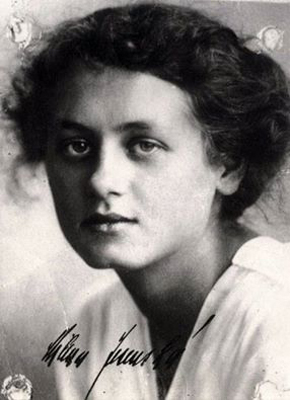
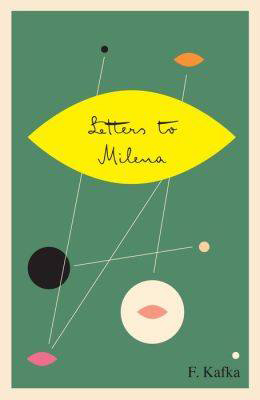
Milena Jesenská and Franz Kafka: A Brief but Intense Connection
In 1919, Milena Jesenská, a Czech journalist, writer, and translator, discovered The Stoker, a short story by Prague writer Franz Kafka. She reached out to Kafka to request permission to translate the story from German into Czech. This letter sparked an intense and increasingly passionate correspondence between the two.
Jesenská and Kafka met twice—spending four days together in Vienna and later a day in Gmünd. Despite their deep connection, Kafka eventually ended the relationship, partly because Jesenská was unable to leave her husband. Their almost daily communication abruptly stopped in November 1920.
However, they remained significant to each other. They exchanged a few more letters in 1922 and 1923, and near the end of his life, Kafka entrusted Jesenská with his diaries.

![]()
the Milena principle. Who are we?






Geert Vermeire (B) [curator, writer, performer and director of the Milena principle], Anna Maria (Annemie) Mestdagh (B) [production assistent, photographer, webmaster], Stefaan van Biesen (B) [visual artist, multi media, sound artist, writer], Filip Van de Velde (B) [art historian, curator and working at S.M.A.K, museum of contemporary art Ghent Belgium], Dr. Simona Vermeire (B/Rom) (literature critic, author, editor), Bregt Smeets (B) [dental research, criminologist].






In the beginning the Milena principle was shaped through the collaboration of Peter De Schouwer (B) (traveller and writer), Julie Snauwaert (B) (teacher, school director), Ann Meeus (B) (nurse & wife of Jan De Wachter), Sylvie Duhamel (B) (visual artist), Herman Bervoets (B) (information expert), Lutgard De Keersmaeker (B) (manager art gallery), Vincent Ghadimi (B) (musician and composer), Imel De Boeck (B) (pharmacist), Niki Fröhling (Nl/G) visual artist), Walter Van Dam (B) (teacher/writer), Dr. Xue Mhin (China/B) (doctor), Ingrid Pee (G) (philosopher), Dr. Rhea Thönges Stringaris (Ger/Gr) (art historian and writer), Margot Dieleman (B) (photographer, WIT: urban team), Eric Windey (B) (visual artist, WIT: urban team), Lynn Louise Pauwels (B) (research the Milena principle - VUB university Brussels), Belinda De Schepper (B/Fr) (wife of Christian Porré).
![]()
In Memoriam:
Jan De Wachter †2020 | Christian Porré †2021 | Eric Philips †2023

![]()
Hospitality for Strangers: an icon.
'Hospitality for strangers' Gustave van de Woestijne 1920 [66,5 x 74,5 cm]
© Museum voor Schone Kunsten Ghent Belgium.
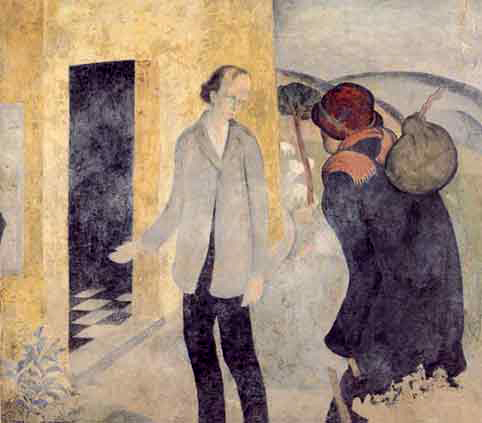

![]()




